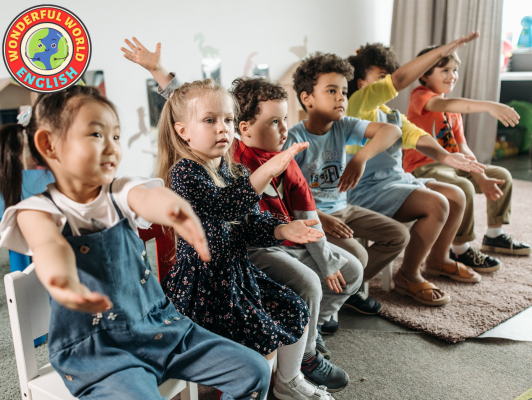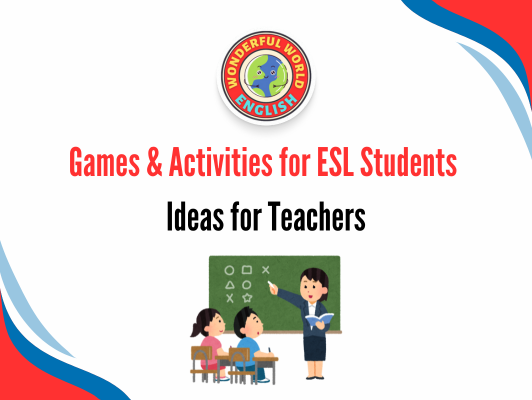Contents
Toggle
Meet David De’ Ath, founder, editor, and writer at Wonderful World English. With his extensive background as an English teacher, David provides valuable insights and practical tips on ESL for students and teachers alike.
Teaching English through games and activities can be a valuable method for new teachers.
It not only makes learning more enjoyable but also helps students retain information better.
By using games, students engage more actively and communicate more effectively.
This interactive approach can build their confidence and foster a positive classroom environment.
Young students, especially those aged six to eight, can benefit significantly from classroom games.
These activities help teachers manage their classes more effectively while providing a fun and educational experience for the children.
With the right tools and strategies, teachers can create a lively and supportive learning space.
You can watch the video below to learn dozens of effective games and activities that you can include in your lesson plans for students of all levels.
Purpose and Tools for New Teachers
New teachers need a variety of tools and strategies to keep their students engaged and help them learn better.
Purpose of Classroom Games
- Enhance Engagement: Games get students more involved and interested in the lesson, making it less likely they’ll be bored or confused.
- Improve Retention: Fun activities help students remember lessons better. Like remembering the lyrics of a favorite song, students remember what they enjoy.
- Encourage Communication: Games get kids talking to each other and the teacher, improving their speaking skills.
- Build Confidence: Fun, interactive activities help young learners feel more secure and willing to participate.
- Create a Positive Environment: A welcoming and fun classroom helps students feel less nervous and more ready to learn.
Useful Tools for Teachers
- Materials in the Classroom: Having the right equipment can make teaching easier.
- Whiteboard and Markers: Essential for writing and drawing during lessons.
- Chalk and Blackboard: Another option if a whiteboard is not available.
- Laptops and Data Show: Useful for presentations and multimedia activities.
- Class Size Management:
- Small Classes (2-15 students): No need for whistles or loud tools; engaging activities will keep students in line.
- Large Classes (30-50 students): A whistle may help in getting the class’s attention quickly.
- Activities for Different Lesson Stages:
- Ice Breakers: Short activities to make everyone feel comfortable.
- Warm-ups: Prepare students for the main lesson.
- Main Activities: Group work, presentations, and other core lesson activities.
- Cool Downs: Fun review activities towards the end of the lesson.
- Review Games: Recap previous lessons in an engaging way.
- Holiday or Seasonal Activities: Themed activities for special occasions like Halloween or Christmas.
- Additional Tools:
- Pens and Paper: For drawing, writing, and creating posters.
- Balls: Useful for games and activities involving movement and interaction.
By using these tools and strategies, new teachers can create a dynamic and interactive learning environment.

Benefits of Using Games in Teaching
Below are some of the major benefits of including games and activities in English lessons:
Enhance Engagement
Games make learning more interesting by involving students actively. Instead of just listening, students participate, making them more interested in the lesson.
Improve Retention
When learning is fun, students remember it better. Games help students recall information more easily, much like remembering the words of a favorite song.
Encourage Communication
Games foster interaction among students and between students and the teacher. This increased communication helps improve their language skills.
Build Confidence
Games can make students feel more comfortable trying out new words and phrases. This boost in confidence is especially important for young learners who might feel shy or unsure.
Create a Positive Classroom Environment
Using games can help create a welcoming and fun atmosphere. This positive setting makes students less anxious and more likely to participate, enhancing their overall learning experience.

Strategies for Activity Selection
Age Appropriateness: Choose activities that fit the age group of your students, typically ranging from 4 to 11 years old. Adjust games slightly to suit older students or even adults if needed.
Engagement and Retention: Activities should be designed to increase student engagement and improve retention. When students are having fun, they are more likely to remember what they’ve learned. Think of it like a favorite song that sticks in your head because you enjoy it.
Communication and Confidence: Encourage communication among students through group activities. These not only get them talking but also build their confidence. This is especially helpful for young learners who might lack confidence.
Positive Classroom Environment: Strive to create a positive and welcoming environment. Use games and activities to make the class enjoyable, thus reducing nervousness among students.
If you’re looking to teach English abroad and embark on the adventure of a lifetime, China awaits!
Click the link below to find out more!

Building a Positive Classroom Environment
Creating a positive classroom environment is essential for effective teaching and learning.
It starts with the teacher’s approach and energy, making the classroom a welcoming and encouraging place.
This helps students feel more comfortable and willing to participate.
Using games and activities can make learning more enjoyable and interactive.
When students are engaged and having fun, they are more likely to remember what they learn.
Games also help in enhancing communication among students, building their confidence, and encouraging them to interact more with their peers and the teacher.
A positive environment not only makes learning more effective but also helps in managing the classroom better.
Students feel more connected and less anxious, leading to a more productive learning experience for everyone involved.
We hope you find value in this information; you can contact us if you are in need of any assistance.
Have a wonderful day!
Image Attribution: All images licensed via canva.com





